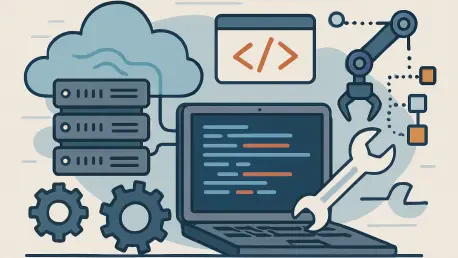Imagine a scenario where the daunting task of configuring servers, networks, and storage systems no longer requires hours of manual effort but can be achieved with just a few lines of meticulously crafted code. This is the transformative power of Infrastructure as Code (IaC), a revolutionary approach that is fundamentally altering how organizations manage their technological environments. By automating the provisioning and management of infrastructure through simple, human-readable configuration files, IaC brings unparalleled speed, accuracy, and consistency to processes that were once riddled with inefficiencies. Far from being a fleeting trend, this methodology represents a profound shift in perspective, treating infrastructure as software and aligning system administration with the principles of modern development practices. As a cornerstone of cloud computing and DevOps, IaC empowers businesses to scale seamlessly and meet the relentless demands of the digital era, making it an indispensable tool for staying competitive in a rapidly evolving landscape.
Understanding the Core Concepts
Defining the Practice of Automation
Infrastructure as Code fundamentally redefines how computing resources are managed by shifting from manual configurations to automated, code-based solutions. At its essence, this practice involves crafting plain-text files, often formatted in languages like JSON or YAML, to describe and deploy infrastructure components such as servers, networks, and databases. This approach ensures that every deployment is repeatable, consistent, and free from the errors that plague manual setups. By encoding infrastructure in a way that can be versioned and tracked like software, teams gain the ability to roll back changes, audit configurations, and maintain a clear history of modifications. This not only streamlines the management of complex systems but also lays a foundation for integrating infrastructure tasks into broader development workflows, making it a vital component of agile and scalable operations in today’s technology-driven environments.
Beyond the technical definition, the significance of this methodology lies in its capacity to transform organizational efficiency by streamlining complex processes. Automation through code eliminates the guesswork and variability inherent in manual processes, ensuring that environments—from development to production—remain identical. This consistency is particularly crucial for businesses operating at web-scale, where even minor discrepancies can lead to significant disruptions. Moreover, by treating infrastructure as code, teams can leverage familiar software development tools and practices, such as version control systems like Git, to manage changes collaboratively. This paradigm not only reduces the risk of human error but also frees up valuable time for system administrators and developers to focus on innovation rather than repetitive tasks, thereby driving productivity and fostering a more resilient infrastructure landscape.
Transitioning to a New Era
The move from manual configuration to automated infrastructure management marks a pivotal evolution in handling modern computing demands, showing how far technology has come. Historically, setting up servers or adjusting network settings required hands-on intervention, often leading to inconsistencies and delays that hindered scalability. With the advent of cloud environments, where resources must be provisioned and adjusted dynamically, such traditional methods have become unsustainable. IaC addresses this challenge by enabling teams to define infrastructure through code, allowing for rapid, error-free deployments across vast and complex systems. This shift is not merely technical but cultural, as it encourages a mindset of automation and precision that aligns with the fast-paced requirements of contemporary digital operations, ensuring businesses can adapt without being bogged down by outdated practices.
This transition also highlights the growing necessity for tools that can manage scale effectively, especially in cloud-centric setups where hundreds or even thousands of resources might need simultaneous configuration. Manual approaches fall short in such environments, often resulting in bottlenecks or costly mistakes. IaC provides a structured solution by automating these processes, enabling teams to spin up or tear down environments with minimal effort. This capability is especially critical during peak demand periods or when testing new applications, as it allows for quick replication of production-like settings without the overhead of manual labor. Furthermore, automation fosters accountability, as every change is documented in code, making it easier to trace issues or revert to previous states. This evolution represents a significant leap forward, positioning organizations to handle the intricacies of modern infrastructure with greater confidence and efficiency.
Tracing the Evolution
Early Beginnings and Growth
The journey of Infrastructure as Code (IaC) began long before it became a buzzword, rooted in the rudimentary scripting practices of the 1990s when system administrators sought ways to automate repetitive tasks. As technology progressed, these basic scripts proved insufficient for the demands of distributed applications and sprawling server farms. The late 2000s marked a turning point with the rise of cloud computing, which exposed the glaring limitations of manual server tuning and necessitated a more robust approach. During this period, the concept of IaC crystallized into a formal practice, driven by the need to manage infrastructure at scale with precision and repeatability. This historical shift laid the groundwork for a new era of automation, fundamentally changing how resources were provisioned and maintained in response to the growing complexity of digital systems and the push for faster, more reliable deployments.
Reflecting on this evolution, it becomes clear that the early adoption of scripting was merely a precursor to a much larger transformation, as the limitations of ad-hoc solutions became apparent with businesses grappling to support web-scale applications. These applications required constant updates and adjustments, highlighting the inadequacy of traditional methods. The introduction of cloud platforms amplified these challenges, as conventional approaches could not keep pace with the dynamic nature of virtualized resources. IaC emerged as the answer, offering a systematic way to define infrastructure through code, ensuring consistency across diverse environments. This period of growth also saw the community of practitioners expand, with shared knowledge and open-source contributions accelerating the refinement of automation practices. The result was a paradigm that not only addressed immediate scalability issues but also set the stage for integrating infrastructure management into the broader software development lifecycle.
Influential Figures and Innovations
Behind the rise of Infrastructure as Code (IaC) stand key figures and tools that have shaped its trajectory into a cornerstone of modern technology. Visionaries like Andrew Clay Shafer, Adam Jacob, and Luke Kanies played instrumental roles in advocating for automation over manual processes, recognizing early on that traditional methods could not sustain the demands of distributed systems. Their ideas spurred the creation of pioneering tools such as Chef, Puppet, and Ansible, which introduced structured ways to manage configurations and provision resources. These early innovations tackled the pain points of managing complex infrastructures by providing frameworks that automated repetitive tasks and ensured consistency. Their contributions not only addressed immediate needs but also inspired a wave of subsequent advancements, cementing IaC as an essential practice for navigating the challenges of cloud-based and large-scale application environments.
The impact of these tools and thought leaders extends beyond their initial offerings, influencing the cultural shift toward automation in technology organizations. Chef and Puppet, for instance, demonstrated how infrastructure could be treated as code, enabling version control and collaborative workflows similar to those in software development. This approach reduced the risks associated with manual errors and allowed teams to scale operations without proportional increases in effort. Meanwhile, the philosophies championed by early pioneers emphasized the importance of repeatability and transparency, principles that remain central to Infrastructure as Code (IaC) today. Their work fostered a community-driven ecosystem where feedback and iteration led to continuous improvement of tools and practices. As a result, the foundation they built has enabled countless organizations to manage complex systems with greater agility, highlighting the enduring relevance of their contributions to the field.
IaC and DevOps Synergy
Uniting Teams for Better Outcomes
Infrastructure as Code serves as a vital pillar in the DevOps ecosystem, creating a seamless connection between development and operations teams. Traditionally, these groups operated in silos, often leading to miscommunication and delays in software delivery. IaC changes this dynamic by automating infrastructure tasks through code, providing a shared language and set of tools that both teams can use. This alignment ensures that developers can provision environments without waiting for manual intervention from operations staff, while operations teams gain visibility into the infrastructure requirements of applications. The result is a collaborative environment where changes are implemented faster, risks are minimized, and the focus shifts from firefighting to delivering value through efficient, streamlined processes that support continuous integration and deployment.
This unification also fosters a culture of shared responsibility, a core tenet of DevOps that Infrastructure as Code (IaC) amplifies. By codifying infrastructure, teams can work from a single source of truth, reducing the likelihood of discrepancies between development, testing, and production environments. This shared understanding eliminates much of the friction that once slowed down release cycles, allowing for more frequent and reliable deployments. Additionally, automation through IaC means that operations teams are no longer bogged down by repetitive manual tasks, freeing them to contribute to strategic initiatives alongside developers. This synergy not only accelerates delivery timelines but also enhances the quality of software by ensuring that infrastructure changes are predictable and testable. Ultimately, IaC acts as a catalyst for breaking down barriers, enabling a more cohesive and responsive approach to building and maintaining digital systems.
Accelerating Delivery with Automation
Within the DevOps framework, IaC plays a crucial role in speeding up software delivery by automating infrastructure builds and changes, ensuring that teams can keep pace with demanding development cycles. Manual provisioning often introduced bottlenecks, as teams waited for servers to be configured or networks to be adjusted, delaying critical updates or new feature rollouts. With IaC, these processes are reduced to executing predefined scripts, allowing environments to be set up or modified in minutes rather than hours or days. This rapid turnaround is essential for maintaining the pace of continuous integration and deployment pipelines, where frequent updates are the norm. By embedding automation into the workflow, IaC ensures that infrastructure keeps up with the iterative nature of modern development, enabling teams to release software more quickly without sacrificing reliability or stability.
The acceleration brought by Infrastructure as Code (IaC) also translates into improved recovery times during incidents, making it a critical asset for modern IT operations. When issues arise, teams can redeploy entire environments from code, bypassing the slow and error-prone process of manual troubleshooting. This capability is particularly valuable in high-stakes scenarios where downtime equates to significant financial or reputational loss. Furthermore, IaC tools often integrate with monitoring systems, providing real-time insights into infrastructure health and enabling proactive adjustments before problems escalate. This combination of speed and oversight transforms how organizations handle both routine deployments and unexpected challenges, making operations more resilient. As a result, the automation fostered by IaC not only boosts delivery speed but also builds a foundation of trust in the infrastructure, empowering teams to innovate with confidence in their ability to manage and recover from setbacks.
Advantages and Obstacles
Unlocking Tangible Benefits
The adoption of Infrastructure as Code brings a host of concrete advantages that reshape how organizations operate in the digital space, transforming their efficiency and reliability. Chief among these is the dramatic reduction in human error, as automation replaces manual configurations that often lead to inconsistencies or missteps. Cost savings also emerge as a key benefit, with streamlined processes cutting down on the labor-intensive tasks that once consumed significant resources. Deployment speed sees a marked improvement, allowing businesses to roll out updates or new services at a pace that matches market demands. Additionally, experts emphasize the confidence gained from testing infrastructure changes in non-production environments, ensuring that modifications are safe before they impact live systems. These benefits collectively enable faster delivery of value, lower the risk associated with changes, and create reliable, accessible systems that support organizational growth and adaptability.
Another critical advantage lies in the enhanced troubleshooting capabilities that Infrastructure as Code (IaC) provides. When issues arise, having infrastructure defined as code means teams can quickly pinpoint discrepancies by comparing current states against intended configurations. This clarity accelerates resolution times, minimizing disruption and maintaining service continuity. Furthermore, the ability to replicate environments with precision ensures that testing and development efforts mirror production settings, reducing the likelihood of unexpected behavior during rollouts. This reliability extends to disaster recovery scenarios, where entire systems can be rebuilt from code, bypassing the uncertainty of manual restoration. By embedding such robustness into infrastructure management, IaC not only saves time and money but also builds a foundation of trust in the systems that underpin critical business operations, making it an essential strategy for navigating the complexities of modern technology demands.
Tackling Emerging Hurdles
While the benefits of Infrastructure as Code (IaC) are substantial, the path to mastery is not without its challenges, particularly as infrastructure environments grow more intricate with increasing complexity. One significant hurdle is the complexity introduced by managing multiple tools and platforms, especially in hybrid or multi-cloud setups where different systems must interoperate seamlessly. This diversity often leads to governance issues, as maintaining uniform policies across disparate tools becomes a daunting task. Configuration drift—where live environments deviate from their coded definitions—poses another persistent threat, undermining the consistency that IaC aims to achieve. Addressing these challenges requires robust strategies, such as implementing drift-detection mechanisms and standardizing tool usage, to ensure that automation remains a strength rather than a source of new problems in sprawling technological landscapes.
Navigating these complexities also demands a shift in organizational mindset and skill sets, adding another layer of difficulty to the process of adopting new technologies. Teams accustomed to traditional methods may face a steep learning curve when adopting Infrastructure as Code (IaC), particularly when integrating multiple tools like Terraform for provisioning and Ansible for configuration management. This transition can initially slow down operations as staff adapt to new workflows and grapple with the nuances of code-driven infrastructure. Additionally, the rise of multi-cloud strategies amplifies dependency management issues, as teams must ensure compatibility and security across varied platforms. To mitigate these obstacles, investing in training and fostering cross-functional collaboration becomes essential. By proactively addressing these hurdles, organizations can harness the full potential of IaC, turning potential pitfalls into opportunities for refining and strengthening their approach to automated infrastructure management.
Tools and Future Directions
Exploring the Automation Arsenal
The landscape of Infrastructure as Code is supported by a diverse array of tools, each tailored to specific aspects of automation and management. Orchestration tools like Terraform and AWS CloudFormation excel at provisioning resources, enabling teams to define and deploy entire environments with precision. On the other hand, configuration management tools such as Ansible, Chef, and Puppet focus on fine-tuning settings within those resources, ensuring consistency in software installations and system states. Often, these tools are used in tandem to cover the full spectrum of infrastructure needs, with orchestration setting the stage and configuration management refining the details. This complementary approach allows organizations to build comprehensive automation workflows, addressing both the creation and ongoing maintenance of complex systems with efficiency and reliability across varied technological environments.
Delving deeper into this arsenal reveals how these tools adapt to the unique demands of modern infrastructure challenges, showcasing their versatility in addressing complex needs. Terraform, for instance, has gained prominence for its ability to manage multi-cloud setups through a single interface, simplifying the oversight of diverse resources. Meanwhile, Ansible stands out for its simplicity and agentless design, making it accessible for teams new to automation. The integration of these tools with version control systems further enhances their utility, allowing for collaborative development and meticulous tracking of changes. This ecosystem also benefits from a vibrant community that continually develops plugins and modules, expanding the capabilities of each tool to address niche requirements. As a result, the IaC toolbox offers a robust foundation for organizations to customize their automation strategies, ensuring they can scale operations and maintain control over increasingly sophisticated infrastructure landscapes without sacrificing agility or precision.
Anticipating Upcoming Shifts
Looking toward the horizon, the field of Infrastructure as Code (IaC) is poised for significant evolution, driven by emerging trends and technological advancements that promise to reshape the landscape. One notable shift is the transition from Terraform to alternatives like OpenTofu, spurred by licensing changes that have prompted communities to seek open-source options with similar capabilities. Simultaneously, the integration of generative AI into IaC workflows is gaining traction, offering the potential to automate the creation of configuration files and reduce manual coding efforts. While this promises efficiency gains, it also introduces risks, such as errors in AI-generated code or security vulnerabilities if outputs are not thoroughly vetted. These developments signal a dynamic future where innovation continues to shape how infrastructure is managed, balancing newfound possibilities with the need for careful oversight.
Another area of focus is the growing emphasis on governance and orchestration in increasingly complex environments, especially as organizations adopt multi-IaC and multi-cloud strategies. Tools that provide unified control and drift detection are becoming critical to maintaining consistency and security across these diverse setups. The rise of Kubernetes-native frameworks like Crossplane illustrates this trend, offering ways to manage resources across platforms with native integration. These advancements aim to address the challenges of sprawling setups, ensuring that automation remains a cohesive force rather than a fragmented effort. Additionally, the push for standardized practices in IaC adoption reflects a maturing field, as businesses seek to mitigate risks through best practices and shared frameworks. This evolving landscape underscores the importance of staying abreast of new tools and methodologies, preparing teams to navigate future complexities while leveraging the full spectrum of automation benefits for sustained operational success.
Reflecting on a Transformative Journey
Lessons from the Past
Looking back on the adoption of Infrastructure as Code (IaC), it became evident that this practice redefined infrastructure management by turning manual processes into automated, code-driven workflows, marking a significant shift in how systems are built and maintained. The early struggles with manual server setups gave way to a systematic approach that prioritized scalability and precision, as seen in the late 2000s with the rise of cloud computing. Tools like Chef and Puppet emerged as lifelines, tackling the inefficiencies of traditional methods and setting a precedent for collaboration between development and operations teams. The benefits, from cost reductions to faster deployments, proved transformative, while challenges like configuration drift highlighted the need for diligence. This historical perspective showed that IaC was not just a technical solution but a cultural shift, embedding automation into the fabric of organizational strategy and paving the way for more resilient digital systems.
The journey also revealed the importance of community and innovation in shaping IaC’s trajectory, highlighting how collaboration and creativity have been pivotal in advancing this field. Early pioneers and their groundbreaking tools demonstrated how shared knowledge could drive progress, turning isolated scripting efforts into a cohesive discipline. Each advancement, from basic automation to sophisticated orchestration, addressed specific pain points, such as the inability of manual processes to support web-scale demands. Reflecting on these milestones, it was clear that the initial investment in learning IaC paid dividends in reliability and speed, even if the path was steep. The lessons learned underscored that embracing change, despite early hurdles, was crucial for staying competitive. These insights from past experiences offered a roadmap for navigating the complexities of infrastructure management, ensuring that the principles of automation remained central to technological evolution.
Building on a Solid Foundation
Moving forward, the legacy of Infrastructure as Code provides a robust platform for future innovation, and organizations should capitalize on this by integrating advanced governance practices to manage multi-cloud complexities. Investing in training programs to upskill teams on the latest tools and methodologies will be essential to overcome initial adoption barriers and maintain momentum. Exploring emerging technologies, such as AI-driven configuration tools, can further enhance efficiency, provided there are stringent validation processes to mitigate risks. Additionally, prioritizing drift-detection mechanisms will help maintain consistency across environments, addressing one of the persistent challenges in automated setups. By focusing on these actionable steps, businesses can transform infrastructure from a potential liability into a strategic asset, ensuring agility and reliability in an ever-changing digital landscape.
Another critical consideration for the future is fostering a culture of continuous improvement and collaboration around Infrastructure as Code (IaC) practices. Encouraging cross-functional teams to share insights and standardize workflows will strengthen the integration of development and operations, amplifying the DevOps synergy that IaC supports. Leveraging community-driven resources and open-source contributions can also accelerate the adoption of best practices, keeping organizations aligned with industry advancements. As the ecosystem evolves, staying proactive in evaluating new tools like OpenTofu or Kubernetes-native frameworks will position teams to handle emerging challenges with confidence. These forward-looking strategies, grounded in the proven benefits of IaC, offer a clear path to not only sustaining but also enhancing the automation gains achieved, ensuring that infrastructure remains a driver of innovation rather than a constraint in achieving business goals.









